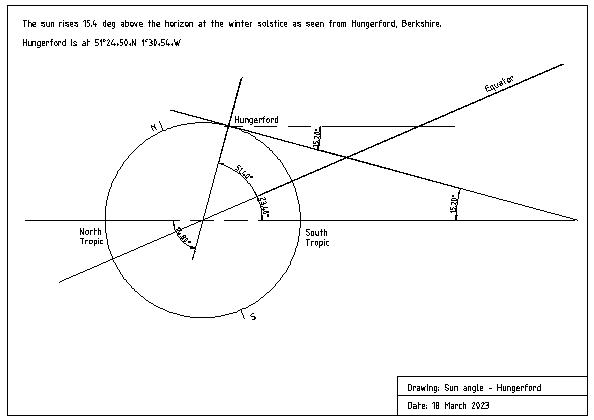The sun appears to move in the sky.
First let’s explore how the sun moves through the seasons. We will consider the sun’s position in the sky at midday (solar noon).
The tropics are at a latitude of 23.4 deg. The northern tropic, the Tropic of Cancer, is at latitude 23.4 deg north and the Tropic of Capricorn is at latitude 23.4 deg south.
In the northern hemisphere winter the sun will be at its lowest in the sky at the winter solstice. At midday on that day the sun will be overhead at the Tropic of Capricorn. Likewise the sun will be at its highest in the sky at the summer solstice and the sun will be overhead at the Tropic of Cancer.
I don’t live on the Tropic of Cancer
If you lived somewhere on the Tropic of Cancer the sun would be overhead on mid-summer day but by mid-winter it would be 46.8 deg lower in the sky. If, on that day, you were to measure the angle of the sun relative to a line from you to the horizon the sun would be 43.2 deg above the horizon.
Now suppose you moved one degree north of the Tropic of Cancer. On mid-winters day the sun would be one degree lower in the sky compared to at the tropic. We can repeat this thought experiment one degree at a time until we have moved 43.2 degrees at which point the sun will appear to be on the horizon on mid-winter day. We will then be at latitude 23.4 + 43.2 = 66.6 degrees north which is known as the Arctic Circle.
Where will the sun be where I live?
To determine the sun’s angle in the sky you need to know your latitude. You can look this up on the internet or get it from a sat-nav.

Let’s suppose you live somewhere along the M4 in the UK. Places such as Marlborough, Hungerford or Newbury are at latitude 51.4 deg north. These places are 66.6 – 51.4 = 15.2 degrees south of the Arctic Circle and so the sun will appear to be 15.2 degrees above the horizon at noon on mid-winter day.